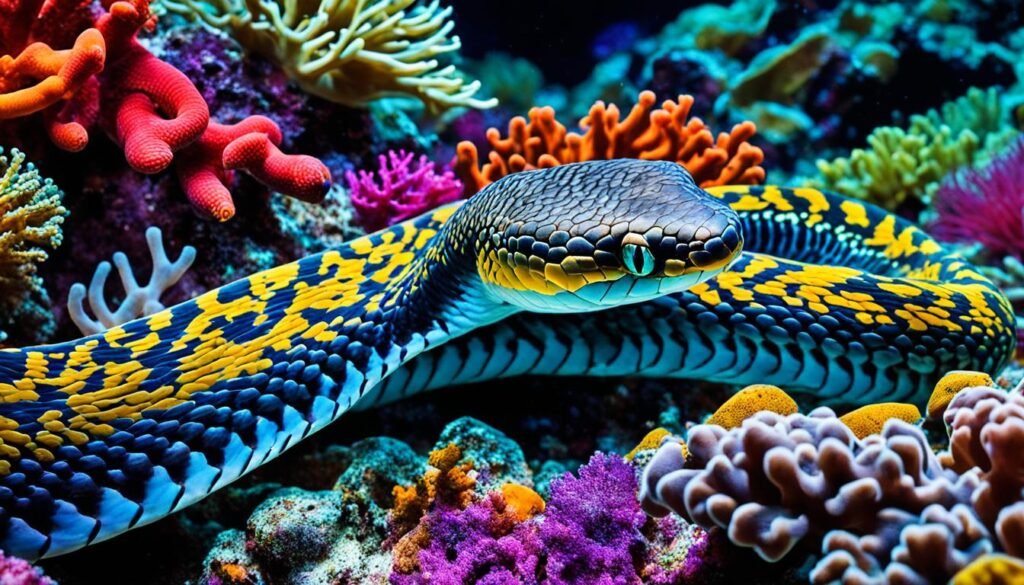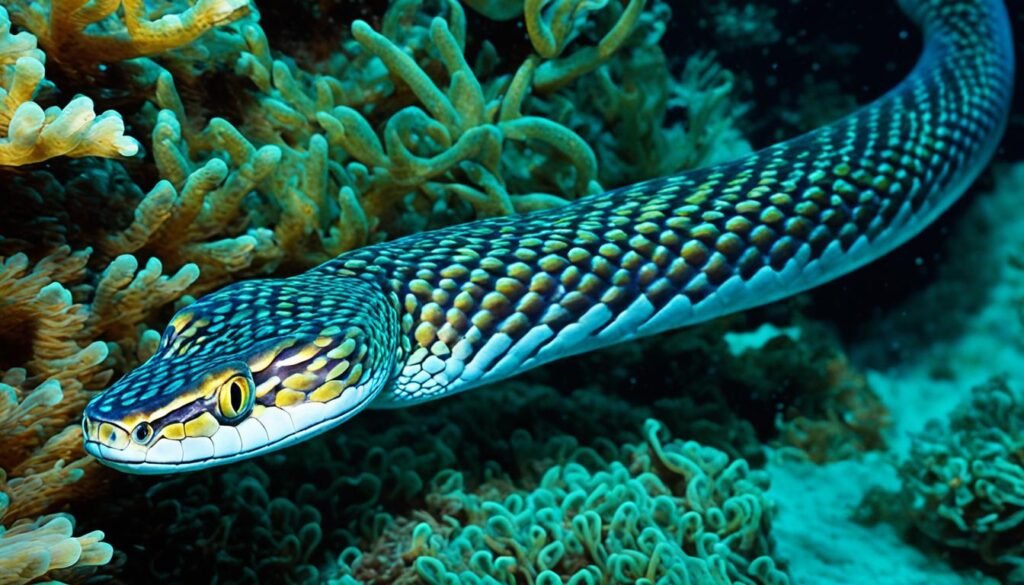Did you know that sea snakes are among the most venomous marine reptiles in the world?
These fascinating creatures, often referred to as sea serpents, elapid snakes, or aquatic vipers, inhabit the ocean depths and coral reefs, contributing to the rich marine biodiversity.
Key Takeaways
- Sea snakes are venomous marine reptiles found in warm waters.
- They are important coral reef predators and play a crucial role in maintaining marine ecosystems.
- Sea snakes have unique adaptations for their underwater life, including flattened tails for swimming and the ability to absorb oxygen through their skin.
- They reproduce and give birth in different ways, with true sea snakes laying eggs and sea kraits giving birth to live young.
- Threats such as habitat degradation, pollution, and bycatch pose challenges to their survival.
Diversity and Distribution of Sea Snakes
Sea snakes are fascinating creatures that thrive in the warm waters of the Indian and Pacific Oceans. Their presence is particularly prominent in regions such as the Coral Triangle, the Andaman Sea, and the Great Barrier Reef. These biodiverse areas serve as rich habitats for a variety of marine species, with sea snakes playing a crucial role as coral reef predators.
Unlike their terrestrial counterparts, sea snakes are not found in the Red Sea, Atlantic Ocean, or Caribbean Sea. They have adapted to the unique conditions of the warm tropical waters, making them a distinctive feature of the Indian and Pacific Oceans.
Two distinct groups of sea snakes, the true sea snakes (Hydrophiinae) and sea kraits (Laticaudinae), occupy different ecological niches within these regions. True sea snakes, also known as pelagic sea snakes, predominantly inhabit open water and deeper offshore environments, venturing far from the coast. On the other hand, sea kraits are more commonly observed in coastal shallows and have even been known to venture onto land.
Let’s take a closer look at the diversity and distribution of sea snakes:
True Sea Snakes
True sea snakes are a subfamily of venomous marine reptiles belonging to the family Elapidae. They are specialists in marine life and have adapted to a fully aquatic lifestyle. With as many as 53 species identified, true sea snakes possess a wide range of adaptations that allow them to thrive in the ocean depths. From the powerful paddle-like tails that facilitate efficient swimming to their unique respiratory systems, these sea snakes are perfectly equipped for life in the open waters.
Sea Kraits
Sea kraits, a subfamily of sea snakes, are semiaquatic reptiles that possess unique characteristics. Unlike true sea snakes, sea kraits can venture onto land and have adapted to life in both aquatic and terrestrial environments. With five recognized species, these kraits exhibit a remarkable ability to navigate the coastal shallows while also possessing adaptations for foraging and breeding on land. Their versatility allows them to occupy multiple ecological niches within their respective habitats.
Understanding the diversity and distribution of sea snakes is crucial in comprehending the complex marine ecosystems they inhabit. It highlights the intricate web of interactions between these fascinating creatures and their surrounding environments, emphasizing the significance of marine biodiversity preservation.
Adaptations of Sea Snakes
Sea snakes have evolved remarkable adaptations that allow them to thrive in their marine environment. These adaptations enable them to navigate the challenges of life both in the water and on land.
One key adaptation of sea snakes is their flattened tails, which serve as efficient propellers for swimming. This streamlined tail shape allows them to move through the water with agility and speed, making them highly efficient predators in their underwater realm. The banded sea krait, a particular species of sea snake, has a body that enables it to crawl on land when necessary, showcasing its remarkable adaptability.
Sea snakes possess the ability to remain submerged for long periods, allowing them to explore the depths of the ocean. They have developed a unique adaptation that allows them to absorb oxygen directly through their skin. This means that, unlike land snakes, they do not need to come up to the surface to breathe air. Sea snakes are capable of remaining underwater for up to eight hours, making them truly remarkable marine creatures.
Respiratory Systems:
True sea snakes and sea kraits have different respiratory systems. True sea snakes have nostrils positioned on top of their snouts that are equipped to close when they are underwater. This adaptation allows them to prevent water from entering their airways and maintain their lung capacity. Sea kraits, on the other hand, have specialized lungs that enable them to extract oxygen directly from the air. This unique adaptation enables sea kraits to spend extended periods of time in both water and on land.
| Adaptations | True Sea Snakes | Sea Kraits |
|---|---|---|
| Tail Shape | Flattened for swimming | Allows crawling on land |
| Oxygen Absorption | Through the skin | Specialized lungs for air extraction |
| Respiratory System | Nostrils close underwater | Direct extraction from air |
These unique adaptations of sea snakes have allowed them to become highly successful marine reptiles, well adapted to their varied and challenging environments.
Reproduction and Life Cycle of Sea Snakes
Sea snakes exhibit fascinating reproductive strategies that contribute to the diversity of reptiles and marine biodiversity. While true sea snakes lay eggs externally like other reptiles, sea kraits have a unique method of giving birth to live young, making them viviparous.
True sea snakes lay their eggs in safe locations, ensuring the survival of their offspring. The embryos develop inside the eggs, offering protection and a controlled environment for their growth. On the other hand, sea kraits nourish the developing embryos inside their bodies until they are ready to be born.
This distinction in reproductive methods allows sea snakes to adapt to their respective environments and increase the chances of their offspring’s survival in the dynamic marine ecosystem. It showcases the remarkable diversity and adaptability of these marine reptiles.
| Reproductive Strategy | Sea Snake Type |
|---|---|
| Oviparous | True Sea Snakes |
| Viviparous | Sea Kraits |
Diet and Predation of Sea Snakes

Sea snakes, being skilled predators, play crucial roles as coral reef predators, maintaining the delicate balance of marine ecosystems. Their diet primarily consists of small fish, fish eggs, and young octopuses. While true sea snakes display activity during both day and night, sea kraits are primarily nocturnal feeders, with a special affinity for eels.
These marine reptiles, along with sea kraits, face predation from various predators in their underwater habitats. Eels, sharks, rays, and other large fish are among the formidable creatures that pose a threat to these sleek predators of the sea.
Let’s explore the fascinating diet and predation dynamics of sea snakes further.
The Diet of Sea Snakes
Sea snakes are highly versatile and opportunistic predators. Their diet consists of:
- Small fish
- Fish eggs
- Young octopuses
This varied diet allows them to adapt to different ecological niches within coral reef ecosystems. Their specialized feeding adaptations enable efficient hunting and consumption of prey in their marine environments.
True Sea Snakes vs. Sea Kraits: Predation Patterns
While true sea snakes and sea kraits share some similarities in terms of diet, they exhibit different predation patterns:
- True Sea Snakes: True sea snakes are active predators during both day and night, allowing them to exploit their environment to the fullest. Their food sources include various small fish and invertebrates that are suitable for their size and hunting abilities.
- Sea Kraits: Unlike their true sea snake relatives, sea kraits are primarily nocturnal hunters. They tend to target eels, their favored prey. The stealthy habits of sea kraits assist them in capturing eels, which can be found hiding in the crevices of coral reefs.
These distinct predation patterns highlight the diverse strategies employed by sea snakes to ensure their survival in different ecological settings.
Threats to Sea Snakes
Sea snakes, like many other marine creatures, face a multitude of threats that endanger their survival and the delicate balance of marine biodiversity. Understanding these threats is crucial in developing strategies to protect these fascinating creatures and their habitats.
Habitat Degradation
Habitat degradation, resulting from human activities such as coastal development, destructive fishing practices, and coral reef destruction, poses a significant threat to sea snakes. These reptiles rely on diverse ecosystems, including coral reefs, seagrass beds, and mangrove forests, for food, shelter, and breeding grounds. The destruction and degradation of these habitats disrupt the delicate balance and interconnectedness of marine ecosystems, directly impacting sea snake populations.
Pollution
Pollution, especially from agricultural runoff, industrial waste, and marine debris, poses a severe threat to sea snakes. These reptiles are vulnerable to chemical pollutants that contaminate their habitats and accumulate in their bodies. Pollutants can disrupt their reproductive systems, weaken their immune systems, and impair their ability to find food and navigate their environment.
Bycatch
Accidental bycatch in fishing nets is a major concern for sea snakes. As non-target species, sea snakes often become entangled in fishing gear, leading to injury, suffocation, and death. The indiscriminate nature of fishing practices, such as trawling and longline fishing, contributes to high mortality rates among sea snakes, further jeopardizing their already vulnerable populations.
Climate Change
Climate change and rising sea temperatures pose additional challenges for sea snakes. As ectothermic reptiles, sea snakes rely on their environment to regulate their body temperature. Increases in sea temperatures can disrupt their reproductive cycles, affect their ability to find prey, and lead to habitat loss as coral reefs bleach and degrade. These changes have cascading effects on the entire marine ecosystem, including the prey availability and ecological balance that sea snakes rely on.
Protecting Sea Snakes and their Ecosystems
Efforts to protect sea snakes and their delicate ecosystems are essential for preserving marine biodiversity. This requires a multi-faceted approach, including:
- Implementing sustainable fishing practices that minimize bycatch and allow for the recovery of sea snake populations
- Reducing pollution through effective waste management and regulation of industrial activities
- Conserving and restoring critical habitats like coral reefs, seagrass beds, and mangrove forests
- Addressing the underlying causes of climate change and working towards sustainable solutions
- Raising awareness and promoting education about the importance of sea snakes in marine ecosystems
By taking these steps, we can protect sea snakes and contribute to the preservation of marine biodiversity for future generations.
Superpowers of Sea Snakes

Sea snakes possess unique adaptations and superpowers that enable them to thrive in their marine habitats. These remarkable creatures have evolved specialized features and abilities that make them highly efficient predators and help them navigate their underwater world.
One of the notable superpowers of sea snakes is their remarkable tongue. Sea snakes use their tongues to gather vital information about their surroundings. Interestingly, their tongues are shorter compared to land-dwelling snakes, which allows them to “taste” molecules in the water more effectively. This adaptation helps sea snakes locate prey, detect potential threats, and navigate through their complex marine environment.
Sea snakes also have sublingual glands located beneath their tongues. These glands serve a crucial function in removing excess salt from their blood. As marine reptiles, sea snakes face the challenge of maintaining osmotic balance in their bodies due to the high salt concentration in the ocean. The sublingual glands help them excrete excess salt, ensuring their survival in their unique habitat.
Moreover, sea snakes possess extraordinary sensory abilities, enabling them to navigate and perceive their surroundings in the ocean depths. They have the ability to detect vibrations and movement, which allows them to locate potential prey and avoid predators. Some studies suggest that sea snakes may even have the ability to sense electromagnetic fields and pressure changes, further enhancing their sensory repertoire.
With their unique adaptations and superpowers, sea snakes contribute to the rich marine biodiversity of our oceans. They are important predators in coral reef ecosystems, playing a vital role in maintaining the balance of marine populations.
To give you a visual glimpse of the incredible sea snakes, take a look at the image below:
Folklore and Mythology of Sea Serpents
Throughout history, sea serpents have captivated the imaginations of people around the world. These mythical creatures have been a prominent part of folklore and mythology, often associated with sea monsters and mysterious tales of the deep. Sea serpents have been mentioned in various cultural and mythological texts, each contributing to the rich tapestry of legends surrounding these enigmatic marine creatures.
Stories depict sea serpents as fearsome beings, capable of wreaking havoc on ships and sailors. They are often portrayed as massive creatures with serpentine bodies, adorned with scales and sharp fins. Tales of their encounters often involve epic battles between brave seafarers and these formidable beasts, infusing them with a sense of awe and terror.
Sea serpents hold a unique place in mythology, symbolizing the unknown and the dangers that lie beneath the ocean’s surface. They embody the mysteries of the deep sea, representing the unfathomable nature of the vast and unexplored underwater world.
The image below evokes the mythical allure of sea serpents:
As with many mythical creatures, sea serpents have become ingrained in our cultural consciousness, shaping our perception of the ocean and its inhabitants. While these creatures may exist solely in folklore and mythology, they continue to spark our imagination and curiosity about the wonders that lie within the depths of the sea.
Conclusion
Sea snakes, with their remarkable adaptations and unique characteristics, continue to captivate scientists and enthusiasts alike. These enigmatic marine reptiles hold many mysteries, enticing us to delve deeper into their world.
As we explore the realm of sea snakes, we discover their crucial role in marine ecosystems. These creatures navigate the ocean depths, contributing to the delicate balance of life beneath the waves. However, human activities pose significant challenges to their survival.
By gaining a deeper understanding of sea snakes and their importance in marine biodiversity, we can take steps to protect and preserve these magnificent creatures. Together, we can ensure their continued existence and maintain the harmony of our oceans for future generations.
FAQ
What are sea snakes?
Where can sea snakes be found?
What are the differences between true sea snakes and sea kraits?
How do sea snakes adapt to their marine environment?
How do sea snakes reproduce?
What do sea snakes eat?
What are the threats to sea snakes?
What are the unique adaptations of sea snakes?
What is the folklore and mythology surrounding sea serpents?
Why are sea snakes important for marine ecosystems?
References
| Organization Name | URL |
|---|---|
| International Reptile Conservation Foundation (IRCF) | https://www.ircf.org/ |
| IUCN Snake Specialist Group | https://www.iucnsnake.org |
| Society for the Study of Amphibians and Reptiles (SSAR) | https://ssarherps.org/about-ssar/ |
| Herpetological Conservation International | https://herpconservation.com/index.html |
Please check out this article if it of interest to you Facts About Turtles: Eunotosaurus And Turtle Evolution


1 thought on “Exploring the Mysteries of Sea Snakes”